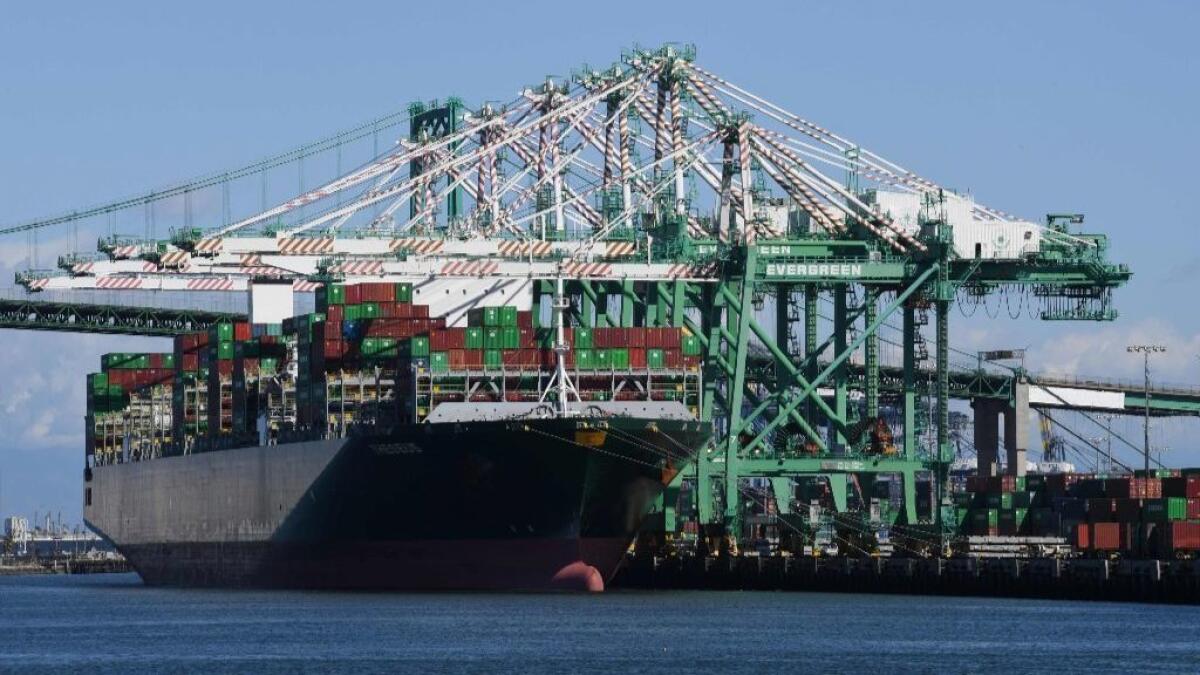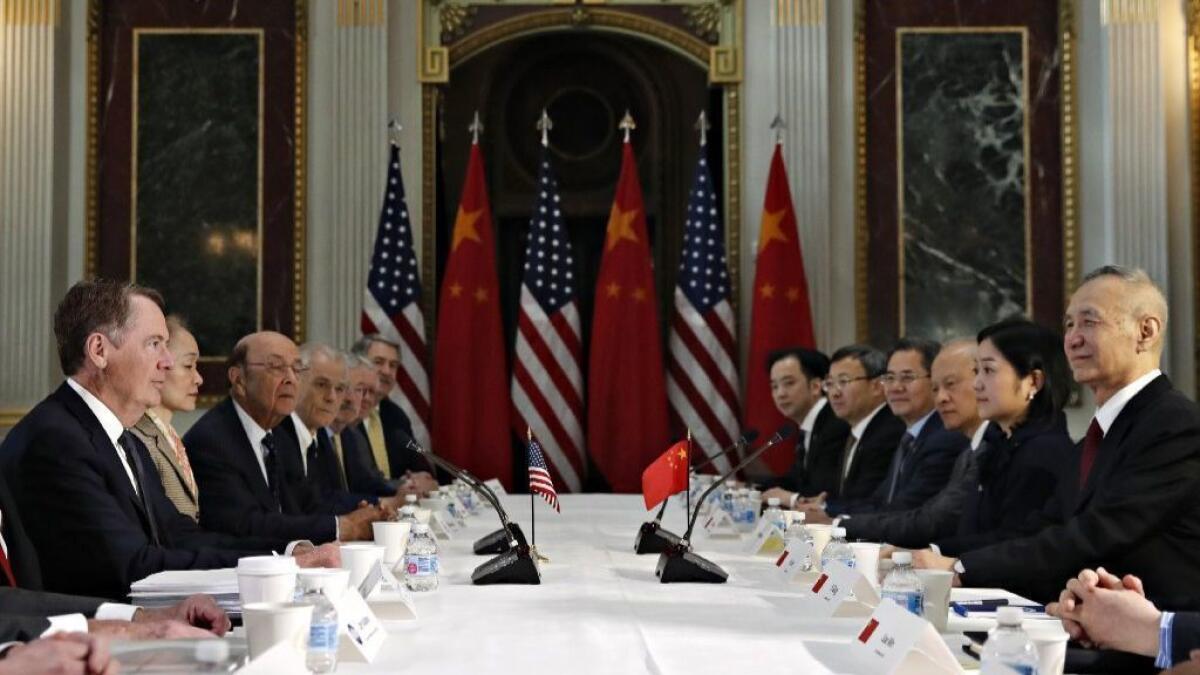Q&A: Why Trump’s tariffs are one of the last big obstacles in U.S.-China trade talks

- Share via
Reporting from Washington — The United States and China are in the final stretch of talks to resolve a conflict over American complaints about China’s unfair trading and economic practices.
Senior U.S. officials say they have reached agreement on enforcement and other key elements of the dispute, raising the possibility that President Trump and Chinese President Xi Jinping could sign a deal in late May.
But at least one big sticking point remains: what to do with all the tariffs that the two sides slapped on each other in the last year. China wants the duties to be lifted. The United States wants to leave at least some of these taxes on Chinese goods in place.
Failure to come to terms on this issue could doom the deal. One thing is certain: It’s in Trump’s hands. And as he has throughout the negotiations, the self-described “Tariff Man” is keeping the world guessing.
Why does Trump love tariffs so much?
Past American presidents typically embraced tariffs for one of three reasons: to raise government revenues; to protect a domestic industry; or to press for reciprocity from a trading partner.
For Trump, it’s all three — and more. He sees the imposition of tariffs, or the threat of them, as leverage to force countries to the table and to make concessions. In Trump’s world of deal-making, tariffs are the weapon of choice, and unlike any U.S. leader in modern times, he has employed them against adversaries and allies alike.
For Trump, tariffs are a win-win because the U.S. government either gets a better deal or collects the revenue, says Douglas Irwin, an economic historian at Dartmouth College. “It’s all good” to him, Irwin said.
What tariffs have the U.S. and China placed against each other?
After his administration concluded that China’s behavior on technology transfer and intellectual property had been harmful to the United States, Trump fired the first big salvo in mid-June 2018. He imposed 25% tariffs on $34 billion in Chinese industrial machinery, electronic equipment and other goods. Beijing immediately retaliated, dollar for dollar, slapping 25% duties on U.S. soybeans, seafood and electric vehicles, among other products.
Since then, there have been two more rounds of tit-for-tat tariffs on thousands of goods exchanged between the two countries. All told, over the last year the United States has placed additional duties of 10% to 25% on about $250 billion of Chinese products, or almost half of all U.S. imports from China. China has applied tariffs of 5% to 25% on about $110 billion of American goods, which represent the vast majority of U.S. shipments to China.
These figures don’t include tariffs on Chinese solar panels, steel and wooden cabinets and other merchandise that has been assessed duties by the Trump administration because of dumping, unfair subsidies and concerns about national security.Trump has threatened to ratchet up the tariff amount and hit all Chinese imports, but he and Xi agreed to a cease-fire on Dec. 1, pending the outcome of the talks.
How much revenue have tariffs raised, and who’s footing the bill?
The U.S. Treasury collected $34.7 billion in tariffs from October to March, up from $18.4 billion in the prior six-month period. That’s an additional $16.3 billion. But as federal budget watchers are quick to point out, the amount is a drop in the ocean. By the Treasury Department’s estimates, Uncle Sam is expected to end this fiscal year with a budget deficit of around $1.1 trillion.
What’s more, the recent gain in tariff receipts looks a lot less impressive when we consider who’s paying the bill. Despite Trump’s claims to the contrary, it’s not China. It’s the American importer and U.S. consumer. Based on a detailed analysis of import data, economists at the New York Fed and Princeton and Columbia universities estimate that Trump’s trade war has had the effect of reducing U.S. real income by $1.4 billion a month.
There are hidden costs as well. One of them is higher premiums for bonds that importers are paying to secure the extra tariff obligations to U.S. Customs, says Ted Murphy, a trade expert at the law firm Baker McKenzie in Washington. “The duties are sort of bad enough,” he says, adding that the bond premiums may not drop even after tariffs are removed.
What’s been the fallout from the tariffs?
Trump’s trade conflict with China, as heated as it’s been at moments, hasn’t slammed economic growth. Trade represents a relatively small share of the U.S. economy, which depends mostly on domestic consumption. Amid steady job and income gains, spurred in part by the GOP tax cuts passed in late 2017, the U.S. economy has continued to grow at a solid pace.
Even so, Trump’s widespread use of tariffs and retaliatory measures from China, as well as other countries, clearly has hurt American businesses. Some have reported higher material prices, supply shortages and transport disruptions. More than anything else, the trade tensions have created a cloud of uncertainty for many, and that has weighed on stock markets and investments.
U.S. farmers have been among the hardest hit as trading partners have aimed their counter-tariffs at various agricultural sectors that are sure to get the attention of American politicians. U.S. soybeans, apples, potatoes, cheese, wine, whiskey, cranberries, tobacco, rice, almonds and seafood are among the many crops and food products facing tariffs from China, Mexico, Canada, the European Union and Turkey.
American farmers have long voted mostly Republican and are an important part of Trump’s rural base of supporters. Scott Henry, a third-generation Iowa soybean farmer, says he’s willing to wait for a bit longer but is getting increasingly anxious.
“Your pleas for patience start to fall on deaf ears,” the 29-year-old says of Trump and others in his administration. “If you’re going to ask for our vote again, at what point do we continue to trust you?”
Read about how one Nebraska farmer is coping with the trade war »
Why does the Trump administration want to leave tariffs in place?
Robert Lighthizer, the U.S. trade representative who is leading the U.S. trade talks with China, would prefer to retain some tariffs as leverage on the Chinese. Duties would come off as Beijing demonstrates it is following through on its promises.
What’s more, analysts say that once the tariffs are removed they will be hard pressed to put them back on during the 2020 election campaign. Another big round of tit-for-tat tariffs would escalate tensions and almost certainly rock financial markets, if not the broader economy, causing a political backlash that no politician, Trump least of all, will want to face.
But there’s another reason some in the Trump White House want to keep the tariffs on. They and others in Washington see Beijing as a serious threat to American interests and want to encourage U.S. firms to shift supply chains away from China, preferably to the United States or a third-party country.
Well before the trade war, U.S. manufacturers in China already had begun to look elsewhere as labor costs and other constraints were making it tougher to do business in China. Arnold Kamler, owner of Bicycle Corp. of America, assembles bikes in South Carolina but produces many more from China for the U.S. market. Kamler is getting ready to open a plant in Phnom Penh, Cambodia, but says he may delay moving production there depending on what happens with tariffs.

How are the two sides likely to resolve the tariff issue?
Most if not all of the tariffs are expected to be lifted if there’s a deal to be had. The U.S. has imposed duties on about twice the amount of Chinese goods as the other way around. The tariffs have hurt China’s already slowing economy, and removal is seen as a political must to save face for Beijing.
Trade analysts who have been in touch with negotiators say that, at this point, the most likely scenario is that the United States will give tariff relief on $200 billion of Chinese goods, retaining 25% duties on $50 billion of imports, including industrial machinery, medical devices, antennas, cars and motorcycles.
If that happens, China would probably also maintain counter-tariffs on $50 billion of U.S. products, although there could be some shifting of products on the tariff list, notably releasing farm goods. Either way, nobody thinks tariffs are going away for good under Trump. To date, the “Tariff Man” hasn’t lifted any tariffs he’s put in force.
More to Read
Inside the business of entertainment
The Wide Shot brings you news, analysis and insights on everything from streaming wars to production — and what it all means for the future.
You may occasionally receive promotional content from the Los Angeles Times.











